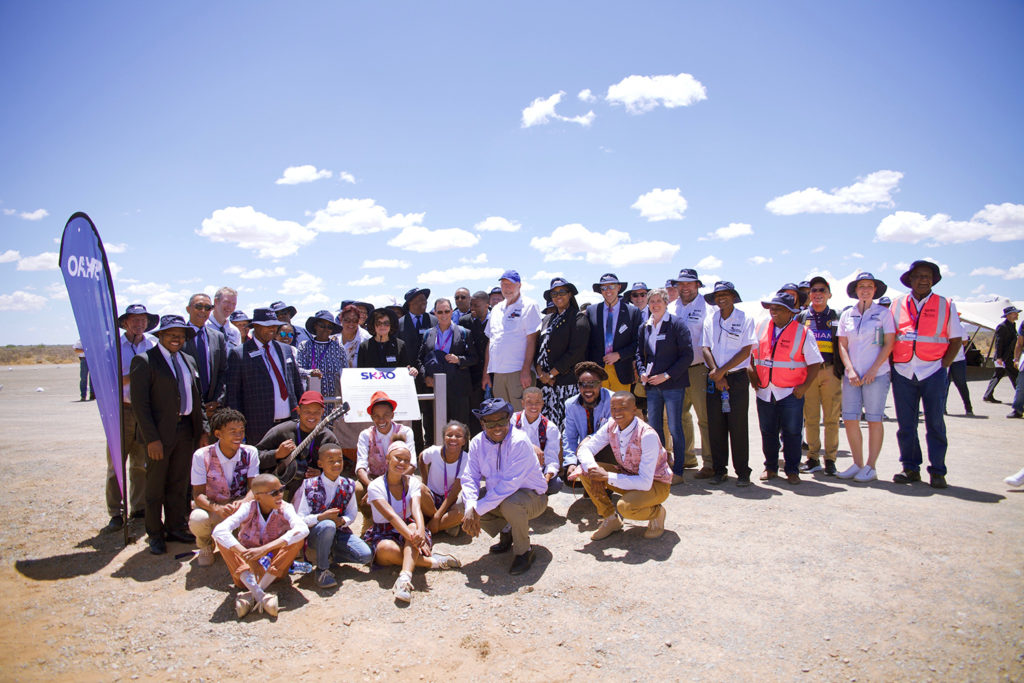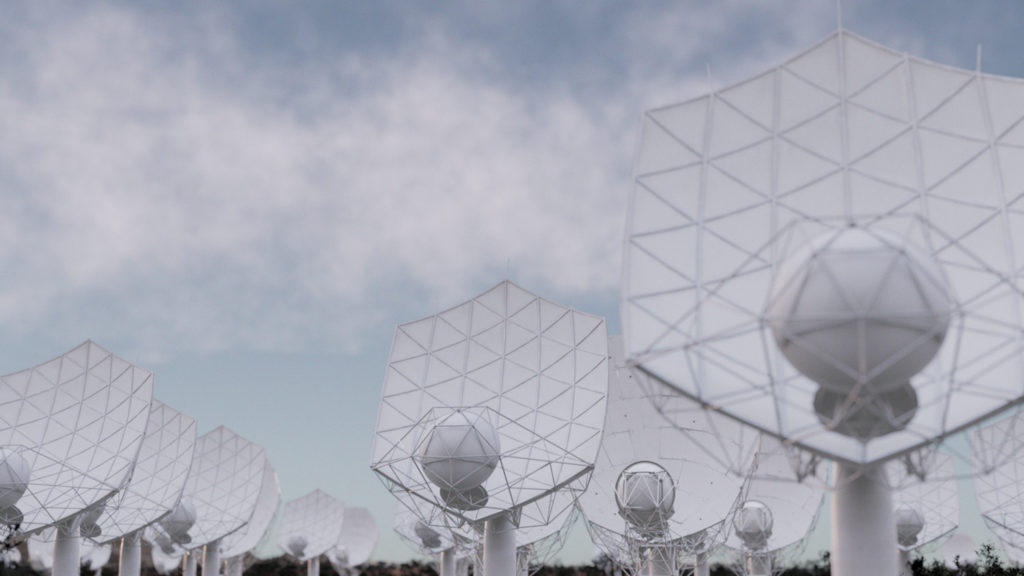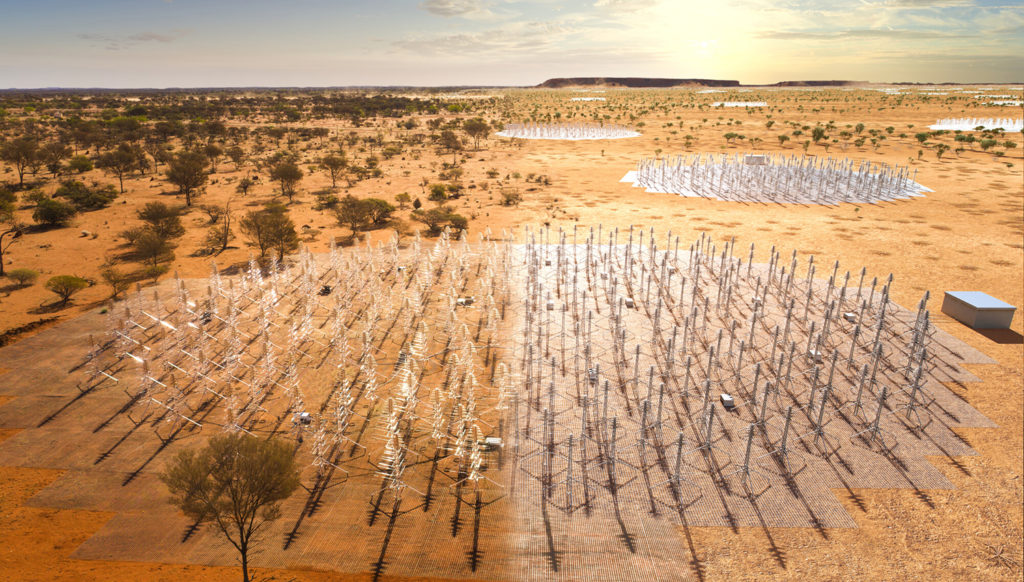In ceremonies at both sites in Australia and South Africa, the SKA Observatory celebrated the start of construction of its world-leading radio telescopes and announced €300 million worth of construction contracts.

The SKAO’s Director-General, Prof. Philip Diamond, travelled to Western Australia to represent the Observatory at the site of the future SKA-Low telescope. Council Chair Dr Catherine Cesarsky attended the event in South Africa’s Northern Cape province where the SKA-Mid telescope will be located.
In her address, Dr Cesarsky said: “The SKA project has been many years in the making. Today, we gather here to mark another important chapter in this 30-year journey that we’ve been on together. A journey to deliver the world’s largest scientific instrument. After 18 months of intense activities around the world, we are starting construction of the SKA telescopes.”
Over the past 18 months, over 40 contracts worth more than €150 million have been entered into by the observatory. On Monday, major new construction contracts worth over €300 million were announced at the ceremonies.
Minister Ed Husic from Australia and South Africa’s Dr Blade Nzimande announced more than €200 million for Australian and South African companies to deliver some of the extensive infrastructure required for the telescopes.
The SKAO also announced the major contracts – worth €100 million – to manufacture the antennas for both telescopes, bringing the total amount of construction funds allocated so far by the observatory to close to €500 million.

Representatives of the communities surrounding the telescope sites had pride of place in both ceremonies. In Australia, guests received a traditional Welcome to Country from members of the Wajarri community, the SKA-Low site’s native title holders and Traditional Owners.
“We’re all connected to this Country, regardless of where we come from,” said Jennylyn Hammett, Wajarri Yamaji Nyarlu (Wajarri Yamaji Aboriginal Corporation Chairperson). “We are Wajarri, we are here and we’re ready to share, so welcome aboard.”
Across the Indian Ocean, attendees witnessed a special “meerkat” version of the ancient riel dance around a newly-cast SKA dish foundation.
The construction commencement ceremonies took place 18 months after the SKAO’s Council approved the building of its two telescopes. Initial procurement concentrated on developing software, contracting professional services firms to help oversee construction, and bulk-buying components such as programmable circuit boards currently in short supply worldwide.
These 40 or so contracts paved the way for construction to start on site. In South Africa, this phase will eventually see 133 SKA dishes added to the existing 64 of the SKA-precursor telescope MeerKAT to form a mid-frequency instrument. Australia will host a low-frequency array of 131,072 antennas shaped like Christmas trees, allowing the two telescopes to cover a wide swath of radio frequencies.

The telescopes require vast infrastructure. Listed company Ventia will put up site-wide power and fibre infrastructure in the SKA-Low telescope’s core and spiral arms and fabricate and commission the central and remote processing facilities. In South Africa, the Power Adenco joint venture will construct gravel access roads, cast dish foundations, lay on power and optical fibre networks, erect security fencing, and more.
Competitive tendering also took place to procure the telescopes’ lead components: the antennas and dishes themselves. On Friday 2 December, the SKAO finalised the two contracts for these critical hardware.
Italian company SIRIO will build the low-frequency antennas for the SKA-Low telescope in Western Australia, with important participation from the UK. In China, one of the Observatory’s long-term partners, CETC54, will manufacture the SKA-Mid telescope’s dish structure. Parts will be produced in several countries, including Italy, Spain, and South Africa.
In their announcements, the science ministers elaborated on the contractual conditions that the SKAO placed on infrastructure providers to include local communities.
In South Africa, the lead infrastructure contractor is required to spend a proportionate amount locally by providing a range of sub-contract opportunities to local SMMEs, on employing, training and transferring skills locally and on other community development initiatives.
In Australia, the aim is to create nearly 100 new roles for the Wajarri Yamaji and locals in the Mid West region of Western Australia.
The Indigenous Land Use Agreement recently signed between the Wajarri Yamaji and the Australian federal and Western Australian governments as well as CSIRO, expanded Inyarrimanha Ilgari Bundara, the CSIRO Murchison Radio-astronomy Observatory to enable construction of the SKA telescope there.
The agreement ensures that Wajarri Yamaji cultural heritage will stay protected and that they will receive sustainable and intergenerational benefits in areas such as enterprise and training and education. About 400 km of ground was surveyed to map areas of cultural significance, and the layout of the SKA telescope array was amended to avoid significant Wajarri heritage sites.
In recognition of the agreement, the Wajarri gifted the site the traditional name – Inyarrimanha Ilgari Bundara, meaning “sharing the sky and stars”.
“We want to be good neighbours to all of the local stakeholders where our infrastructure is located,” said Prof. Diamond. “It’s important that we play our part in supporting the local economy as well as the national one, and we’re doing our small part to ensure this is the case. For example, we’ve instructed infrastructure contractors to ensure local businesses are engaged and benefit from those contracts as well.”
With its large infrastructure and telescope component contracts in place, the SKAO is on track to reach its next milestone: ensuring that the first four SKA-Mid dishes and six SKA-Low stations (of 256 antennas each) work together as a telescope.
The first two antenna stations are due to be completed by May 2023, while the first dish is set to be installed in April 2024, followed by three to four dishes each month.
Procuring mass-produced dishes and antennas represents a step-change for radio astronomy. Instead of bespoke and one-off components, manufacturers can develop new techniques to produce such elements, potentially offering new product lines.
Thanks to the telescopes’ design as interferometers – where the signals of multiple telescopes are combined to act as one giant telescope – the first notable scientific results can be expected before the telescopes are completed at the end of the decade.
The SKA telescopes will be managed from the SKAO’s Global Headquarters at Jodrell Bank near Manchester in the United Kingdom. Scientists will use the two arrays over the course of their expected 50-year lifespan to answer crucial questions about the earliest epochs of the universe, and unravel some of the most profound mysteries in astrophysics.
“As the host country of CERN, Switzerland is pleased to be part of this great intergovernmental, scientific and technological endeavour and is looking forward to the scientific community having access to the SKA,” said Switzerland’s State Secretary for Education, Research and Innovation, Martina Hirayama of Switzerland’s involvement in this important research endeavour.
“Great challenges lie ahead, but I trust that together we will be able to meet them. I am convinced that the SKA will allow us to achieve scientific breakthroughs, which will enable us to expand the boundaries of our knowledge,” Dr Hirayama continued.
“The SKA telescopes will truly revolutionise our understanding of the universe,” said Dr Cesarsky. “They will allow us to study its evolution and some of its most mysterious phenomena in unprecedented detail, and that’s really exciting for the scientific community.”